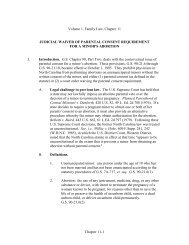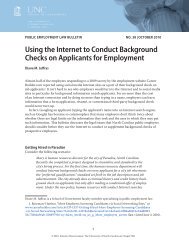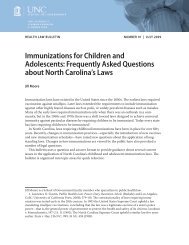Responding to Subpoenas for Health Department Records
Responding to Subpoenas for Health Department Records
Responding to Subpoenas for Health Department Records
- No tags were found...
You also want an ePaper? Increase the reach of your titles
YUMPU automatically turns print PDFs into web optimized ePapers that Google loves.
<strong>Health</strong> Law Bulletin No. 82 September 2005produce originals in response <strong>to</strong> a subpoena <strong>for</strong> aproceeding in court, you should make copies <strong>for</strong>yourself ahead of time because the court may retainthe originals while the case is pending. If you aresubpoenaed <strong>to</strong> a deposition (or <strong>to</strong> produce records ata person’s office), the party who issued the subpoenais responsible <strong>for</strong> having copies made; he or she doesnot have a right <strong>to</strong> retain the originals. 29Remember that producing the records is not thesame thing as disclosing them. If the records containconfidential in<strong>for</strong>mation, you may not be authorized<strong>to</strong> disclose them until ordered <strong>to</strong> do so by a judge.See Question 29, below.Question 20. Can I mail copies <strong>to</strong> thecourt instead of producing them inperson?Perhaps. There are two considerations. The firstis whether the subpoena rules permit the mailing in ofrecords. Rule 45(c)(2) of the North Carolina Rules ofCivil Procedure contains a “mail-in” procedure <strong>for</strong>certain types of records only. In lieu of appearing andproducing the requested documents, the personsubpoenaed may send certified copies of the records,along with an affidavit (a sworn statement) ofauthenticity, <strong>to</strong> the judge presiding over the case (orthe judge’s designee, such as the court clerk). If theperson subpoenaed does not have any of therequested documents, he or she may send an affidavitso stating. 30The mail-in procedure is available only if (1) thesubpoena is directed <strong>to</strong> a cus<strong>to</strong>dian of hospitalmedical records or public records and (2) thesubpoena requires the cus<strong>to</strong>dian <strong>to</strong> appear <strong>for</strong> the solepurpose of producing those records. The definition of“hospital medical records” is broad enough <strong>to</strong> covermany of the types of medical records maintained byhealth departments, and most other health departmentP. 45(c)(2) (when mailing-in of records is permissible, it issufficient <strong>to</strong> mail true and correct copies).29. Various arrangements can be made <strong>for</strong> copyingrecords subpoenaed <strong>to</strong> a deposition or document production(assuming it is permissible <strong>to</strong> disclose them). There is noset rule. For example, if you produce the originals, thesubpoenaing party may decide <strong>to</strong> pho<strong>to</strong>copy particulardocuments; or you and the subpoenaing party may agreethat you will pho<strong>to</strong>copy all of the documents (be<strong>for</strong>e orafter your appearance date) and that the subpoenaing partywill pay the costs.30. Sample affidavits will be available on www.medicalprivacy.unc.edu.records are public records (such as mostenvironmental health records). 31 However, thesecond condition allows the party who issues thesubpoena <strong>to</strong> eliminate the mail-in option byindicating in the subpoena that the cus<strong>to</strong>dian mustappear and testify as well as produce documents. Onthe subpoena <strong>for</strong>m attached <strong>to</strong> this bulletin, theissuing party would check two boxes—one requiringthe cus<strong>to</strong>dian <strong>to</strong> appear and testify and anotherrequiring the cus<strong>to</strong>dian <strong>to</strong> produce documents. Someat<strong>to</strong>rneys will check both boxes even though they justneed the cus<strong>to</strong>dian <strong>to</strong> produce the records and attest<strong>to</strong> their authenticity. If that is the sole reason you arebeing asked <strong>to</strong> appear, you may be able <strong>to</strong> use themail-in procedure assuming that the procedure isotherwise permissible. If you are unsure of why youare being subpoenaed, contact the issuing at<strong>to</strong>rney <strong>to</strong>clarify.Assuming Rule 45 authorizes use of the mail-inprocedure, a second consideration is whether theconfidentiality laws governing the particular31. Rule 45(c)(2) states that hospital medical recordsare as defined in G.S. 8-44.1. That section states thathospital medical records are “records made in connectionwith the diagnosis, care and treatment of any patient or thecharges <strong>for</strong> such services except that records covered byG.S. 122-8.1 [now, G.S. 122C-52], G.S. 90-109.1 andfederal statu<strong>to</strong>ry or regula<strong>to</strong>ry provisions regarding alcoholand drug abuse, are subject <strong>to</strong> the requirements of saidstatutes.”Rule 45(c)(2) does not define “public record.”However, since one of the purposes of the mail-inprocedure in Rule 45(c)(2) is <strong>to</strong> allow a party <strong>to</strong> introducecertified copies of certain records without having <strong>to</strong> call awitness at trial <strong>to</strong> authenticate the records, the pertinentrules in the North Carolina Rules of Evidence onauthentication of public records may supply the appropriatedefinition. See NORTH CAROLINA EVIDENCE RULE 902(4)(<strong>for</strong> purposes of admission of certified copies of publicrecords without the testimony of an authenticating witness,“public record” means “[a] copy of an official record orreport or entry therein, or of a document authorized by law<strong>to</strong> be recorded or filed and actually recorded or filed in apublic office, including data compilations in any <strong>for</strong>m,certified as correct by the cus<strong>to</strong>dian or other personauthorized <strong>to</strong> make the certification, by certificatecomplying with . . . any law of the United States or of thisState”); see also 2 KENNETH S. BROUN, BRANDIS & BROUNON NORTH CAROLINA EVIDENCE § 243, at 264–65 & n.32(6th ed. 2004) (discussing Rule 902 of the North CarolinaRules of Evidence and Rule 45(c) of the North CarolinaRules of Civil Procedure).10













